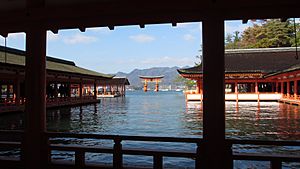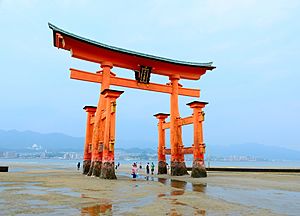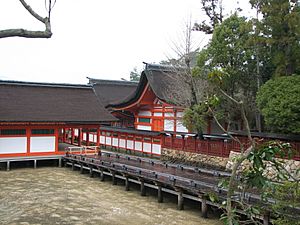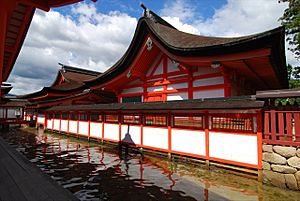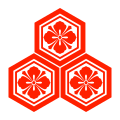Itsukushima Shrine facts for kids
| UNESCO World Heritage Site | |
|---|---|
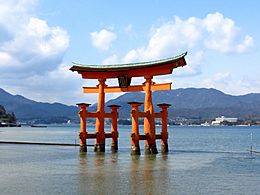
The torii of Itsukushima Shrine, the site's most recognizable landmark, appears to float in the water
|
|
| Location | Itsukushima, Japan |
| Criteria | Cultural: i, ii, iv, vi |
| Inscription | 1996 (20th Session) |
| Area | 431.2 ha |
| Buffer zone | 2,634.3 ha |
| Itsukushima Shrine | |||||
|---|---|---|---|---|---|

"Itsukushima Shrine" in kanji
|
|||||
| Japanese name | |||||
| Kanji | 嚴島神社 | ||||
|
|||||
Itsukushima Shrine (厳島神社 (嚴島神社), Itsukushima-jinja) is a famous Shinto shrine in Japan. It is located on Itsukushima Island, also known as Miyajima. This beautiful shrine is best known for its "floating" gate, called a torii.
The shrine is found in Hatsukaichi city, in Hiroshima Prefecture. You can reach it from the mainland by taking a ferry. Itsukushima Shrine is a UNESCO World Heritage Site. The Japanese government has also named many of its buildings and items as National Treasures.
Itsukushima Shrine is one of Japan's most popular places to visit. People love its amazing torii gate, the sacred Mount Misen, and the beautiful ocean views. The shrine has two main buildings: the Honsha shrine and the Sessha Marodo-jinja. There are also 17 other buildings and structures that make it special.
Contents
History of Itsukushima Shrine
How the Shrine Began
Itsukushima Shrine was once the most important Shinto shrine in the area called Aki Province.
Some say the shrine was first built in 593 CE by Saeki Kuramoto. This was during the time of Empress Suiko. However, the shrine you see today is mostly thanks to Taira no Kiyomori. He was a powerful noble who helped build much of the shrine in 1168. Kiyomori was the governor of Aki Province at that time.
Another important person who helped the shrine was Mōri Motonari. He was a lord who rebuilt the main hall in 1571. Motonari had fought a war on the island in 1555. Fighting and spilling blood was against the strict rules of Shinto. These rules keep the shrine pure and sacred. The only part of the shrine that remains from the old days is the Kyakuden, or "Guest-God's Shrine."
Kiyomori's Influence on the Shrine
In the 1100s, it was common for rich nobles to build shrines. This showed off their power and wealth. The Taira family, to which Kiyomori belonged, was very involved in sea trade. They wanted to control trade along the Inland Sea.
Kiyomori was very powerful when he took control of Itsukushima Island. He ordered the main hall of Itsukushima Shrine to be built. He did this to show respect to the god of navigation. It also served as a base for his sea activities. Soon, Miyajima became the Taira family's special shrine.
Kiyomori also chose this spot to show he was different from other nobles. He spent a lot of money on Itsukushima. He loved showing the shrine to his friends and even to royal people.
It is also said that Kiyomori rebuilt the shrine after a dream. In his dream, an old monk promised him power over Japan. This would happen if he built a shrine on Miyajima Island. He also had to honor the gods there for his success. The money from the Taira family helped Itsukushima become a very important religious place.
Religious Importance of Itsukushima
Itsukushima Shrine is dedicated to three goddesses. They are the daughters of Susano-o no Mikoto. Their names are Ichikishimahime no mikoto, Tagorihime no mikoto, and Tagitsuhime no mikoto. These three are known as the sanjoshin, or "three female deities." They are the goddesses of the seas and storms.
Kiyomori believed these goddesses were like Kannon, a wise being. So, the island was seen as a home for this holy figure. In Japanese, Itsukushima means "island dedicated to the gods." The island itself is thought to be a god. This is why the shrine was built on the edge of the island, over the water.
Adding to its sacredness, Mount Misen is the tallest peak on the island. It is about 1,755 feet high. Visitors can hike or take a cable car to the top.
The shrine holds special treasures. One is the famous Heike Nōkyō. These are "Sutras dedicated by the House of Taira." They are 32 scrolls copied by Kiyomori and his family. Each scroll was decorated with silver, gold, and mother-of-pearl.
Itsukushima was originally a very pure Shinto shrine. No births or deaths were allowed there. This was to prevent pollution. The island itself was considered sacred. For a long time, ordinary people were not allowed to step on it. This kept its purity.
Keeping the shrine pure is still very important. Since 1878, no deaths or births have been allowed near it. Pregnant women are supposed to go to the mainland when their baby is due. Very sick or elderly people also leave if they are close to passing away. Burials are not allowed on the island.
To let visitors come close, the shrine was built like a pier over the water. This makes it look like it is floating, separate from the land. The red entrance gate, or torii, was also built over the water for the same reason. In the past, people had to steer their boats through the torii to reach the shrine.
Architecture of the Shrine
Japan has worked hard to keep the shrine's 12th-century style. The shrine was built in the Shinden-zukuri style. It has pier-like structures over the bay. This makes it look like it is floating on the water. It seems separate from the island, like a "palace on the sea."
This idea of mixing buildings with nature was popular in the 16th century and the Heian period. Japanese buildings often fit into their surroundings. Trees, water, and other natural beauty became part of homes and buildings. This created a closer link between nature and architecture.
The most famous part of Itsukushima Shrine is its 50-foot tall red otorii gate. This "great gate" is made of strong camphor wood. It has extra legs in front and behind its main pillars. This style is called Ryōbu Shintō, a type of medieval Japanese Buddhism.
The torii only looks like it's floating at high tide. When the tide is low, you can walk to it from the island. Many people enjoy looking for shellfish near the gate at low tide. At night, bright lights on the shore light up the torii. The first gate was built in 1168, but the one you see today is from 1875.
Shinto architecture has many special parts. These include the shrine's honden (main hall) and the long haiden (main prayer hall). It also has a long heiden (offering hall). The honden is a large building with a special roof. Its walls are covered in white stucco and red wood.
Next to the main shrine is a noh stage from 1590. Noh theater shows have long been used to honor the gods. They act out important stories from Shinto myths.
On September 5, 2004, a strong typhoon damaged the shrine. The walkways and roof were partly broken. The shrine was closed for repairs for a while. Today, anyone can visit the shrine for a small fee.
Images for kids
-
Barrels of sake in one of the shrine's "floating" buildings
-
Chashitsu in its garden setting, circa 1900
Artwork Featuring the Shrine
-
Aki Province: Itsukushima, Depiction of a Festival (Aki, Itsukushima, Sairei no zu by Hiroshige
-
Itsukushima in Aki Province by Hiroshige
-
Miyajima in Aki Province by Kunisada
-
Mori Motonari Attacking Sue Harutaka at Itsukushima by Yoshitoshi
-
Itsukushima moon (Itsukushima no tsuki) by Yoshitoshi
More to Explore
 In Spanish: Santuario Itsukushima para niños
In Spanish: Santuario Itsukushima para niños
- Munakata Taisha which was dedicated to the same goddesses
- List of World Heritage Sites in Japan
- Tourism in Japan
- Mont Saint-Michel, a sister city and a similar island-temple UNESCO World Heritage Site
- Three Views of Japan
- Hiroshima to Honolulu Friendship Torii (Itsukushima replica)


